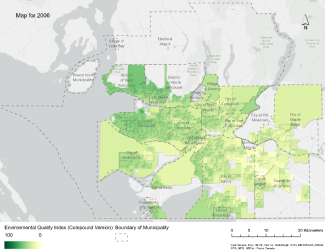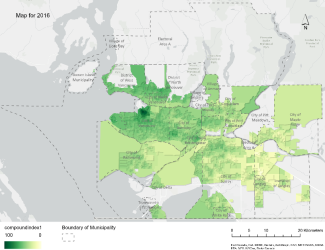Shuoqi is a second-year MSc student and an incoming Ph.D. student in the Lab for Environmental Assessment and Policy at UBC, supervised by Dr. Amanda Giang. She aspires to provide scientific evidence for policy and decision-making in environmental management.
Everyone has the right to a healthy, and sustainable environment; however, disadvantaged groups sometimes experience disproportionate exposure to environmental risks or lack of access to benefits, defined as distributive environmental injustice. Additionally, the changing climate and environment may advance injustice over time. Given the unclear spatial and temporal distributions of multi-dimensional environmental quality and environmental justice in Metro Vancouver, our study first generated environmental quality maps at dissemination area resolution for 2006 and 2016 using different methods. We then explored spatial and temporal distributional environmental injustice patterns. Across our different metrics, we find that more material and socially deprived populations lived in areas with fewer environmental benefits and/or more burdens. Injustice is also not improving for all groups over time, for instance, South Asian residents of the region. Furthermore, our study identifies specific DA with high percentages of disadvantaged populations, unfavourable environmental quality, and high levels of injustice, which could suggest priorities for interventions and adaptations.
Next step: Papers are currently being drafted based on the current findings. Our next step for this study will be both quantitatively and qualitatively exploring the drivers of the changing environmental quality and injustice patterns in Metro Vancouver.
Figure 1 Environmental quality in Metro Vancouver for 2006 (1a) and 2016 (1b) visualized by the constructed index. A higher index value indicates a favourable environment.

